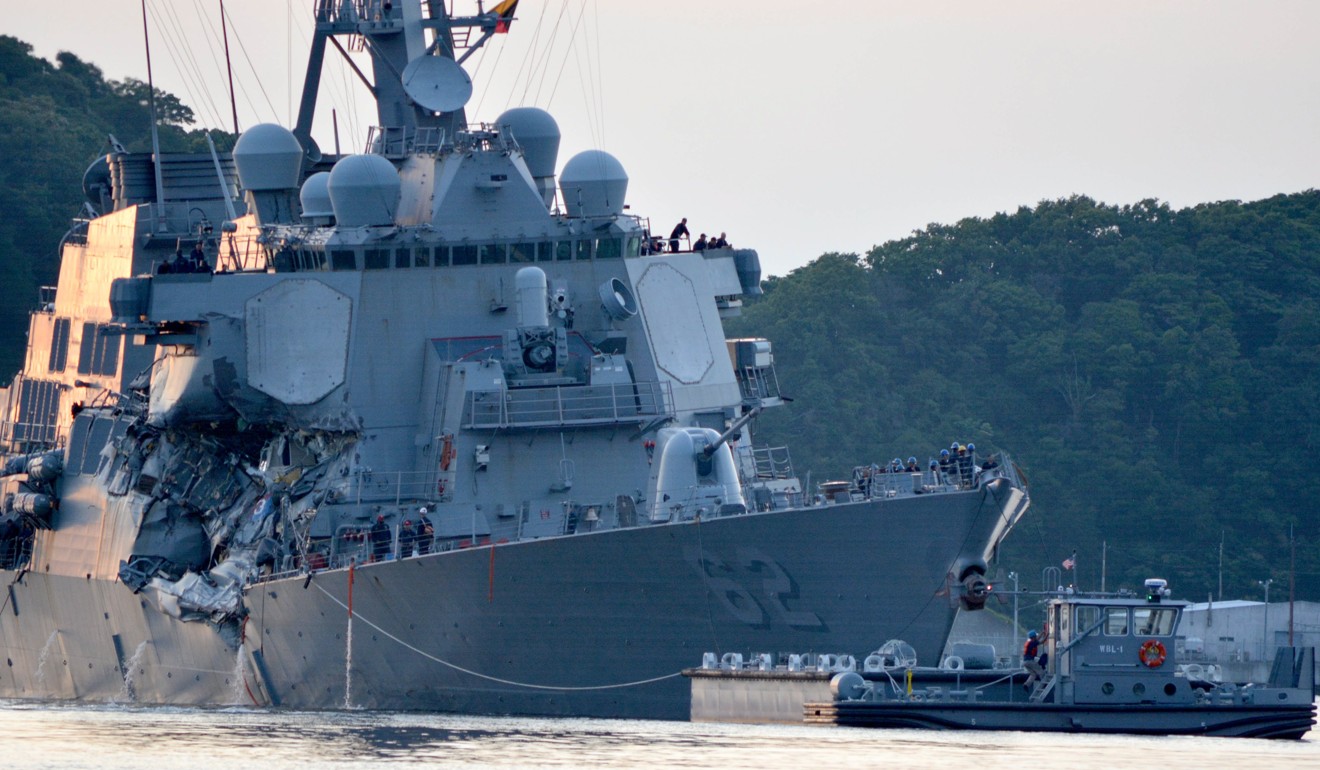
Captain of US destroyer involved in deadly collision to lose command
Poor seamanship and flaws in keeping watch contributed to a collision between a Navy destroyer and a commercial container ship that killed seven sailors, Navy officials said, announcing that the warship captain will be relieved of command and more than a dozen other sailors will be punished.
Admiral William Moran, the vice chief of naval operations, told reporters on Thursday that the top three leaders aboard the USS Fitzgerald, which was badly damaged in the June collision off the coast of Japan, will be removed from duty aboard the ship. They are the commanding officer, Commander Bryce Benson; the executive officer, Commander Sean Babbitt; and Master Chief Petty Officer Brice Baldwin, who as the ship’s command master chief is its most senior enlisted sailor.
“The collision was avoidable, and both ships demonstrated poor seamanship,” the Navy’s 7th Fleet said in a statement, noting that “flawed” teamwork among those assigned to keep watch contributed to the collision.
The actions are being taken by Rear Admiral Joseph Aucoin, commander of the 7th Fleet, based at Yokosuka, Japan, because he lost confidence in the three, Moran said.
The Navy said the three had shown “inadequate leadership”. Separately, seven junior officers were relieved of their duties because they had shown “poor seamanship” and bad teamwork, 7th Fleet spokesman Commander Clay Doss said on Friday.

Administrative penalties were handed out to seven others that were members of the watch teams, he said, without giving details. All 14 remain in the Navy, but they will be assigned to other jobs, he said.
The Navy’s investigation into how and why the USS Fitzgerald collided with the container ship has not yet been completed, but enough details were available to decide on Friday’s actions, the Navy said.
Doss said the specifics of what led to the collision were related to preparations for litigation and cannot be released.
“Serious mistakes were made by members of the crew,” Moran said, adding that he could not fully detail those mistakes because the investigation is ongoing.
He said “the bridge team,” or the sailors responsible for keeping watch on the ship’s bridge to ensure it remains safe, had “lost situational awareness”, which left them unable to respond quickly enough to avoid the disaster once the oncoming container ship was spotted.
Separately, the Navy released the results of a review of events that took place aboard the ship after the collision, focusing on the crew’s efforts to control damage, save lives and keep the ship afloat.
The crash occurred in the pre-dawn hours of June 17 off the coast of Japan in an accident-prone area known for congestion. That is within Japanese territorial waters. The seas were relatively calm, and visibility was unrestricted. The bow of the container ship, the Philippine-flagged ACX Crystal, slammed into the Fitzgerald’s right side above the waterline, quickly flooding several areas inside the ship, including a berthing, or sleeping, area.
Of the 35 sailors who were in Berthing 2 at the time, 28 escaped. Seven drowned.

The collision knocked out external communications and cut power in the forward portion of the ship.
The Navy review of what happened aboard the ship following the collision found that the seven deaths could not be blamed on misconduct. It commended the response by the ship’s crew, singling out two sailors for taking extra steps to help other out of the flooded berthing space — actions that it said likely saved the lives of at least two of their shipmates.
“No damage control efforts, however, would have prevented Berthing 2 from flooding completely within the first two minutes following the collision, or the deadly circumstances in that situation,” the review said.

Within 30 to 60 seconds, the berthing was flooded, and the water was waist deep, the study said. Mattresses, furniture, an exercise bicycle were floating in the aisles.
The sailors tried to escape and helped each other, looking for their mates. One sailor got pinned between floating lockers and was barely able to pull himself free. The seven sailors who died were sleeping in the area closest to and directly in the path of the incoming water, the study found.
The report said that although some in Berthing 2 heard a loud noise at the time of the collision or were thrown from their beds by the force of the impact, some did not realise what had happened and remained in bed. Some remained asleep.
“At least one sailor had to be pulled from his rack and into the water before he woke up,” it said.
The Japanese and US coast guards are conducting their own investigations.
Japan’s Coast Guard is “not in a position to make any comments on the Navy’s investigation,” spokesman Yoshihito Nakamura said.
Yoshinori Fukushima, spokesman for the operators of the container ship ACX Crystal, also declined to comment, saying they had yet to see the Navy report.

